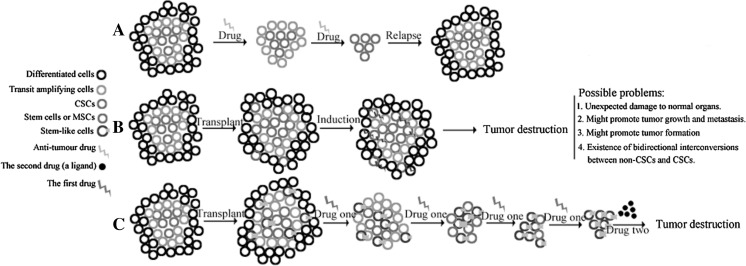Fig. 1.
Schematic representation of possible ways to cure cancer. a The CSC model pointed out that tumors are heterogeneous and are regarded as perturbed versions of the normal tissue, containing a small fraction of drug-resistant CSCs that are responsible for high frequency of relapse after chemotherapy. b Stem cells and in particular MSCs have been experimentally used and clinically explored for efficient delivery of therapeutic transgenes. However, conflicting reports showed that in some cases these cells could promote the metastasis and growth of a tumor. The therapeutic uncertainty of this treatment strategy stalls its clinical application. Our hypothesis is illustrated in c. In this treatment strategy, the stem-like cells transplanted resemble the ‘cancer cells’ of the abnormal tissue–the tumor. In the presence of the drug one, which acts as an environmental pressure favoring the self-renewal of the transplanted cells over that of CSCs, transplanted cells gradually take over the CSC niche. Then, the drug two, which could induce the expression of the incorporated suicide genes in the stem-like cells, kills the progenies of those seeded cells. Since in our model CSCs are replaced by other stem-like cells rather than killed by environmentally hostile agents to kill cancer cells, this strategy may circumvent the shortcomings of treatment methods as illustrated in a and b

